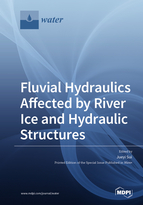Velocity Field and Turbulence Structure around Spur Dikes with Different Angles of Orientation under Ice Covered Flow Conditions
Round 1
Reviewer 1 Report
This is a very interesting article about the impact of ice covers in case of implementation of spur dikes on rivers.
It gives an insight to the three-dimensional velocity components and turbulence inside and outside the scour hole in spur dikes' vicinity based on results from laboratory experiments.
Results from this study can improve the practical implementation of spur dikes (e.g. selecting the appropriate orientation angle of the spur dike).
I would suggest to add some more photos from the experiment that would support better the explanations regarding the created scour holes.
There are some spelling errors to be corrected.
Author Response
Please see the attachment
Author Response File: ![]() Author Response.pdf
Author Response.pdf
Reviewer 2 Report
Dear Authors, you have done very interesting research using an impressive simulation structure. The work is very interesting, but there are several significant shortcomings, so the manuscript needs serious revision. You can find my remarks, comments, and questions in the file.
Comments for author File: ![]() Comments.pdf
Comments.pdf
Author Response
Please see the attachment
Author Response File: ![]() Author Response.pdf
Author Response.pdf
Reviewer 3 Report
The introduction section and literature review is written well. In lines 98-99 I will only suggest to refer to the first published paper about under ice velocity distribution: Larsen, P.A., 1969. Head losses caused by an ice cover on open channels. J BOSTON SOC CIV ENG, VOL 56, NO 1, P 45-67, JAN 1969. 23 P, 20 FIG, 4 REF.
The first sentence in section 2 is rather colloquialism, is not quite formal or literary. That one used in ordinary or familiar conversation. Please change it.
The schematic view and description of the laboratory flume is not easy to understand. I suggest to add photo of the original site and extend the description.
the ice cover was the main factor which making that study original; thus, I am a bit disappointed by the amount of information included in the site description part. Please add information about following:
- how the cover was installed on the water surface?
- How the authors ensure that the cover was in contact with water?
- How was the pressure measured along the cover
- Wat this Styrofoam divided into the section or it was one continuous piece covering entire section?
- What was the roughness of both types of cover – include the calculations for cover roughness in the paper.
Result section: All measurements of the 3D water velocities were conducted using ADV sensor, thus all figures should provide the data in form of points instead of lines.
The location of the ADV profiles is not clear. Please show it on the sketch or provide suitable description. Since authors compare data for different spur dike layout and deferent flow condition, I guess the profiles should be identical for each experiment>
I wonder if authors proceed the experiments in one profile only or in the entire area? I never seen in the paper the velocity filed in the entire area, which makes me wonder that the entire study is based on the single velocity profile? Please clarify it. In my opinion the study should cover the entire area of the spur dike to avoid local effects.
Author Response
Please see the attachment
Author Response File: ![]() Author Response.pdf
Author Response.pdf
Round 2
Reviewer 2 Report
please see attached comments
Comments for author File: ![]() Comments.pdf
Comments.pdf
Author Response
Please see attached file
Author Response File: ![]() Author Response.docx
Author Response.docx
Reviewer 3 Report
The roughness coefficient should be calculated based on the velocity profiles. The proposed approach is not proper for laboratory experiments. Besides - what is the 'ks ' for Styrofoam?
Provide the measured values not interpreted lines. Is a research paper based on laboratory experiments so you need to provide data not interpretation. The answer is not acceptable.
Looking at the description in the approach (reply to my comment 7) I don’t think the results should be published in current form. I suggest continuing on this study and after you produce reliable material you can consider sharing it with world.
Author Response
Please see attached file
Author Response File: ![]() Author Response.docx
Author Response.docx




